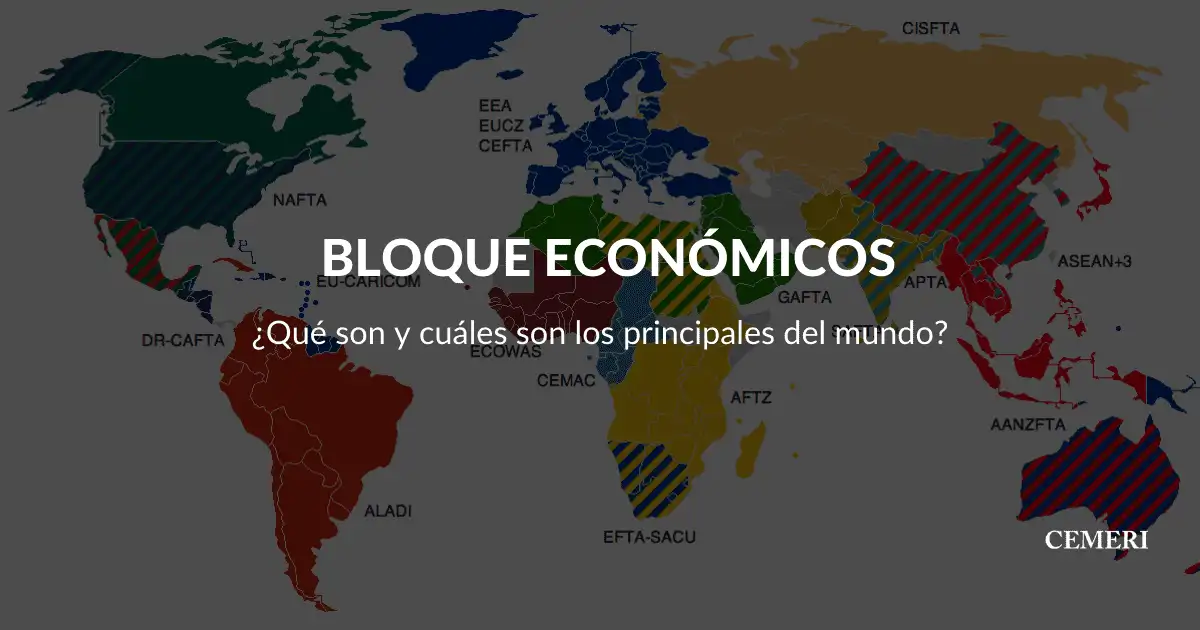Encyclopedia
Marco Olivera
What and what are the main economic blocks in the world?
- There are different types of economic blocks that are defined based on the level of economic integration, such as the monetary union, the customs union, the economic union, etc.

The world's economic blocs are some form of intergovernmental agreements, often part of a regional intergovernmental organization, where regional barriers to international trade (tariff and non-tariff barriers) are reduced or eliminated between participating states, allowing them to trade easily.
The objective of the formation of the block is to increase the flow of goods, services, capital and labor, depending on the type and stage of the agreement. Ultimately, this increases the economic power of member countries, stimulates economic growth, and encourages more efficient resource allocation. Although the formation of economic blocs, such as the European Union and the USMCA, have led to the creation of trade between members, in the same way it is also more difficult for countries outside the bloc to trade.
Likewise, when international economic blocks act as one, they play an important role in international relations.
What is the origin of the economic blocks?
Historically, the first economic bloc was the Zollverein (German for customs union) promulgated in 1834 by most of the German Confederation, a 19th-century group of kingdoms made up of the present-day countries of Germany, Austria, the Czech Republic, Luxembourg and parts of other neighboring countries. The Zollverein removed trade barriers between member territories while raising tariffs on countries outside the union, as many economic blocs around the world do today.
In the 20th century, a large increase in trading blocs was noted in the 1960s and 1970s, and later in the 1990s with the end of the Cold War and the triumph of economic and political liberalism.
Industrial complex of the Zollverein coal mine in Esse.
Photo: Stiftung Zollverein
What types of economic blocks exist?
There are different types of economic blocs that are defined based on the level of economic integration, such as monetary union, customs union, economic union, preferential trade areas, and free trade and common market areas.
Free Trade Area
The free trade area involves ensuring the removal of trade restrictions between members. Thus, goods and services flow freely between them.
Regarding non-member trading, each has separate and different policies. Some members may charge higher fees or taxes, while others are lower. They also offer other types of tax benefits.
The difference in tariffs provides opportunities and benefits for non-member countries. They will export to member countries that set low tariffs. After entering the destination country, they can send it to other member countries at no cost. This phenomenon is what we call trade diversion.
Customs union
A customs union is a more advanced stage than a free trade area. Its main objective is to overcome the trade diversion problem inherent in the free trade area agreement. Members of the customs union agree to achieve joint tariffs when trading with non-members. Therefore, there is no opportunity for non-member countries to benefit from tariff differences.
Common Market
The common market is a combination of customs unions plus the removal of barriers to the flow of factors of production. So, under this agreement, the member states agree:
- Eliminate trade barriers in goods and services.
- Eliminate barriers to capital and labor flows (factors of production).
- Member countries have uniform policies regarding trade with non-member countries.
Trade barriers can be tariff and non-tariff. Protection policies, such as subsidies, are also eliminated. Upon success, member countries will generally harmonize some micro-policies, such as regulations on monopolistic and anti-competitive practices.
economic union
Economic unions combine all aspects of the common market and also coordinate economic policy. The member countries then form joint economic institutions for this purpose. An example is the formation of the economic union of the European Union.
So if the member countries agree to adopt a single currency, we will call it a monetary union. The eurozone is an example, where it consists of members of the EU that adopt the euro as their currency.
Advantages and disadvantages of economic blocks
The benefits and disadvantages of the economic block depend on how the member states take the agreement. Each type of trading block has a different exposure to each member country. In addition, fundamental economic factors, such as economic structure, competitive conditions, technological advancement, labor flexibility, affect the outcome of cooperation.
**Advantages **
Some of the benefits of forming a trading block include:
Lower prices and more varied products: The elimination of tariffs leads to lower prices for consumers in member countries. The free flow also increases access to a wider variety of goods.
Larger market: Companies can increase their sales to other member countries without worrying about protection. The broader market allows them to take advantage of economies of scale.
Promote direct investment: In common market and union economies, capital flows freely, which encourages companies to increase investment and create jobs in some member countries.
Access to cheaper and more abundant capital: Under an economic union, companies can take advantage of member countries that have more developed financial markets.
Promote specialization: The increase in trade allows greater specialization, so member countries develop more efficient industries.
Decrease monopoly power as competition increases: Goods and services flow freely and create greater choice for consumers. It increases competition in the market and forces companies to increase innovation and efficiency to remain competitive.
Positive effect on knowledge abundance and technology transfer: In a common market or economic union, capital and professional workers move freely between member countries, allowing for a positive effect on knowledge and technology.
Better quality intermediate inputs: This is because production factors can freely enter and leave member countries, as in common markets and economic unions.
Minimize the potential for conflict between members: Members, who previously competed, can adopt mutual policies that are favorable to them.
Increase economic power: Gives members a stronger bargaining position on trade policies and agreements because they form a united front.
Provides new opportunities for trade and investment: Member countries benefit from domestic investment and increased trade opportunities.
Growth in member countries also tends to spread to other members: Economic expansion in one member country increases demand in other members.
Closure of the national industry: Increased competition creates winners and losers. If national industries are not competitive, they go out of the market and increase unemployment. The danger is even greater if many industries are not competitive and absorb a significant workforce.
Greater economic dependence: The economic performance among member countries is interconnected. The economic crisis in one member spreads to other member countries. The impact is even broader due to the significant size of the trading bloc's economy. Examples include the debt crises in Greece, Italy, and Spain, which required the intervention of the European Central Bank to handle. The intervention was to prevent the impact of the crisis from spreading to other countries in the bloc.
Loss of state sovereignty: The trading bloc makes decisions for all members. It may conflict with the internal economic interests of some States. In addition, decisions may favor member countries with a more significant size of the economy.
Brings out trade fun: The trade bloc distorts the benefits of world trade. Inefficient firms within the bloc can still survive and are shielded from competition from more efficient firms outside the bloc.
Retaliation from third countries: To protect their economies, they are likely to form new trading blocs to defend their positions.
Which are the 10 largest economic blocks in the world?
According to the International Comparison Program (PCI) of the World Bank, in 2017 (last reference year of the initiative) the largest economic or commercial blocs in the world were:
1.- Regional Integral Economic Association (RCEP):
In 2017, its member countries collectively accounted for 29.8% of global GDP based on Purchasing Power Parity (PPP).
On November 15, 2020, the ten member countries of the existing Association of Southeast Asian Nations (ASEAN) trade bloc - Myanmar, Brunei, Cambodia, Indonesia, Laos, Malaysia, Philippines, Singapore, Thailand and Vietnam - along with Australia, New Zealand, China, Japan and the Republic of Korea have signed a new agreement called the Regional Comprehensive Economic Partnership (RCEP), which is expected to enter into force within two years and become the world's largest free trade area. .
Of all RCEP signatories, China is the largest economy, accounting for 55% of the trading bloc's PPP-based GDP. ASEAN member countries, which include countries as economically diverse as Vietnam and Singapore, account for 21% of the new trading bloc's economy. Japan and Korea comprise 20% of GDP based on RCEP PPP and Australia and New Zealand make up the remaining 4%.
Signing of the Regional Comprehensive Economic Partnership (RCEP) agreement was held via video conference in Hanoi, Vietnam on November 15, 2020.
Source: Xinhua
2.- Treaty between Mexico, the United States and Canada (T-MEC):
It entered into force in July 2020, replacing the old North American Free Trade Agreement (NAFTA or NAFTA in English), and represents 19.9% of world GDP based on PPP. Before the RCEP agreement, this was the largest trading bloc in the world.
3.- European Union:
The block made up of Austria, Belgium, Bulgaria, Cyprus, Croatia, Denmark, Slovenia, Spain, Estonia, Finland, France, Greece, Hungary, Ireland, Italy, Latvia, Lithuania, Luxembourg, Malta, the Netherlands (Holland), Poland, Portugal, the Czech Republic, the Slovak Republic, Romania and Sweden account for 18.5% of global GDP based on PPP, and the euro area countries account for 71% of GDP based on EU PPP.
Strong commercial relations, economic development and the free movement of people are some of the characteristics of this bloc in Europe.
It should be noted that although most countries belong to the European Union, millions of citizens of other European countries want their respective States to have as one of their objectives to join the bloc in the future.
4.- South Asia Free Trade Area (SAFTA):
After RCEP, SAFTA is the second largest trading bloc in terms of demographics, accounting for almost a quarter of the world's population and 8.5% of world GDP based on PPP. However, intraregional trade remains low, due to tariffs on goods imported from other member countries, real and perceived non-tariff barriers, and connectivity costs. Its members are Afghanistan, Bangladesh, Bhutan, India, Maldives, Nepal, Pakistan, and Sri Lanka.
5.- Eurasian Economic Union (EAUA):
Composed of Armenia, Belarus, Kazakhstan, Kyrgyzstan and Russia, the Eurasian Economic Union (EAEU) came into force in 2015 as the successor to the Eurasian Customs Union. This trading bloc is a single integrated market accounting for 3.8% of world GDP based on PPP. The Russian Federation represents 85% of the EAEU economy.
6.- Cooperation Council for the Arab States of the Gulf (CCEAG):
In Western Asia, the Gulf Cooperation Council (GCC) is both a customs union and a common market, accounting for 2.4% of world GDP based on PPP.
Although the GCC has the capacity for further integration, regional conflicts have hampered regional cooperation and deterred trade integration.
The Council consists of: Bahrain, Kuwait, Oman, Saudi Arabia, United Arab Emirates and Qatar.
Mercosur:
In South America, the Southern Common Market (Mercosur) is the largest trading bloc, accounting for 3.6% of world GDP based on PPP.
Mercosur is made up of Argentina, Bolivia, Brazil, Paraguay, Uruguay and Venezuela (suspended). Andean Community (CAN): Another important player in the Latin American region is the Andean Community (CAN), which contributes 1.2% of world GDP based on PPP.
This Andean block is made up of: Bolivia, Colombia, Ecuador and Peru. Chile was part of the pact, but in 1976 it withdrew by order of then President Augusto Pinochet. Central American Integration System (CAIS): the group of countries of Belize, Costa Rica, El Salvador, Guatemala, Honduras, Nicaragua, Panama and the Dominican Republic make up the Central American Integration System (CAIS).
The CAIS is a free trade area that together represent 0.5% of global GDP based on PPP. Despite the longevity of this organization, established in 1991, intraregional trade remains low and future integration efforts are uncertain.
There is also a similar block, the Central American Common Market (MCCA). Created in 1960, it is made up of five countries in the region, but they do not represent a GDP similar to that of the CAIS. Continental Free Trade Area (CFTA): The only bloc in Africa on the list is the CFTA.
It is a free trade area that covers almost all the countries of the African continent; specifically, it is made up of all members of the African Union, except Eritrea, and represents 5% of global GDP based on PPP.
It entered into force in May 2019 after gathering 22 ratifications and entered its operational phase in July of the same year.
Sources
SIN FUENTES

